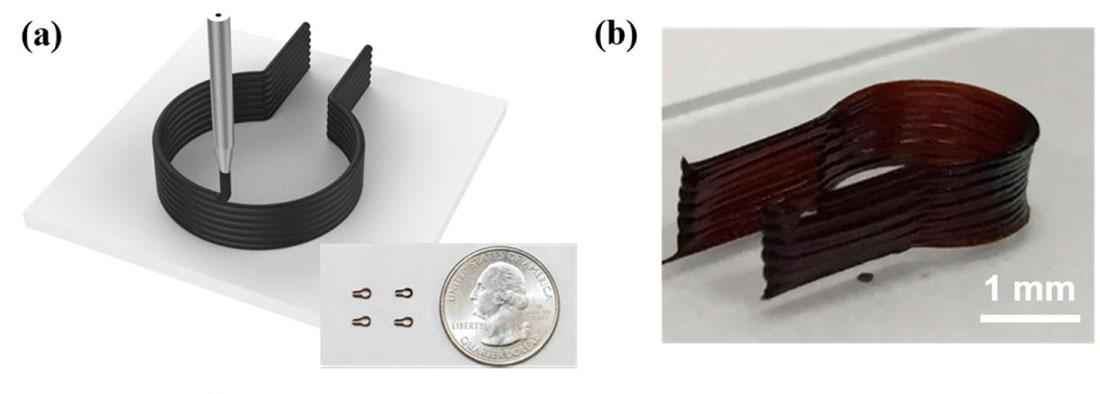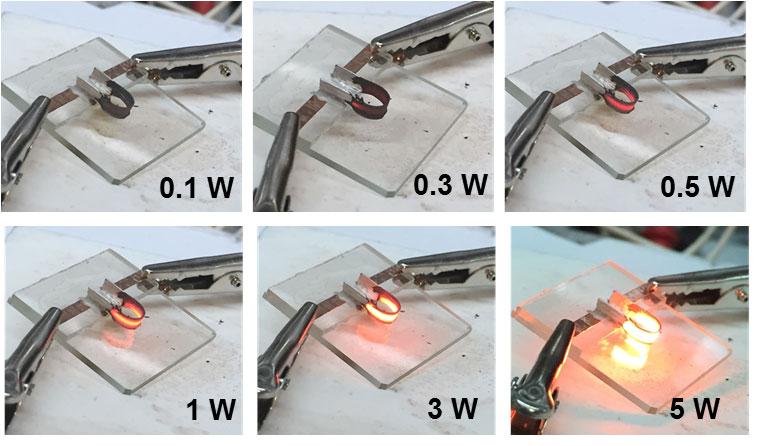 In a laboratory setting, tiny high-temperature heating elements are typically used to initiate controlled chemical reactions in order to produce materials synthesis. This process is used when developing new compound materials or to produce a specifically desired byproduct of the chemical reaction. The typical heating elements used have several limitations, especially when working with materials at a micro-scale. These heating devices are often quite bulky in size and weight, have low maximum heating temperatures and slower than optimal ramp rates. While laser heating can produce high temperatures at a small scale, it is expensive, provides very poor consistent temperature distribution throughout the sample, and the effectiveness is dependent on the materials being worked with.
In a laboratory setting, tiny high-temperature heating elements are typically used to initiate controlled chemical reactions in order to produce materials synthesis. This process is used when developing new compound materials or to produce a specifically desired byproduct of the chemical reaction. The typical heating elements used have several limitations, especially when working with materials at a micro-scale. These heating devices are often quite bulky in size and weight, have low maximum heating temperatures and slower than optimal ramp rates. While laser heating can produce high temperatures at a small scale, it is expensive, provides very poor consistent temperature distribution throughout the sample, and the effectiveness is dependent on the materials being worked with.
In an effort to develop micro-scale heating elements that do not have these limitations, a research group at the University of Maryland was looking for alternative methods of manufacturing a heating element capable of producing a range of high temperatures that will be able to target objects in a micro- or nano-scale environment. The researchers have developed a method of 3D printing very small high-temperature, high-rate heaters capable of being applied to a wide range of nano-scale manufacturing processes — specifically applications that require precise temperature control, timing and controlled placement, as well as situations where the temperature ramping rate is vital to successfully producing the desired reaction.

(a) RGO inks are used to 3D print small 1.5 mm heating elements (see scale next to quarter). (b) The as-3D printed horseshoe-shaped heater. [Image: American Chemical Society]
“Our 3D-printed heater uses graphene oxide. When electrical current is applied to this heater, it can generate high temperatures (3,000 K) with exceptional fast rate (in less than 100 millisecond, an estimated heating rate 20,000 K/s) and superior stability (>2,000 cycles, with continuous high temperature lasting for more than a day without noticeable decay),” explained Yonggang Yao, a graduate student in the University of Maryland’s BingNano Research Group.
These micro heating units can be 3D printed in virtually any 3D shape using an extremely concentrated aqueous graphene oxide ink. The process developed by the research team has led to the fast and low-cost prototyping of micrometer-scale, 3D printed custom-shaped heating elements. The team’s current 3D printing technology has allowed them to produce horseshoe-shaped heaters that have features as small as 200 µm. When graphene oxide is carbonized it becomes reduced graphene oxide (RGO), a highly conductive and stable material that is capable of operating under very high temperatures and in high vacuum environments. These small, 3D printed RGO structures will be capable of functioning as high-performance heating elements in a wide variety of clinical and laboratory settings.

(c) the RGO heater is operated by running an electrical current through it, which causes the temperature to rise based on the strength of the current. (d) the real 1.5mm RGO heater producing extremely high temperatures. [Image: American Chemical Society]
“The high temperature is provided by Joule heating, a simple, highly efficient and finely controllable way to generate high temperature in conductive materials. No metal or ceramic based furnaces/heaters can reach such a high temperature since most metals melt and ceramics decompose at such high temperature,” Yao told NanoWerk.

The temperature of the heating element rises based on the level of electrical current being run through it. [Image: Bing Research Group, University of Maryland.]
“In the current stage, the size of our heating element measures in microns; our goal is to achieve 3D nanoprinting. So far, this has been a challenge for us, which requires us to learn more about the graphene oxide inks and designing new 3D printers. In addition, we hope to increase the temperature from 3,000K to even higher temperatures that can be potentially used to explore the unknown properties of materials in such extreme high temperature environments,” Professor Liangbing Hu said.
In addition to producing high rates of stable heat, these heaters are just as stable while being operated in high vacuum environments. This feature makes them ideal heating units for use inside electron microscopes, which will allow researchers to closely observe any reactions and structure changes to materials when exposed to high temperatures. The small scale of the 3D printed heaters and the controllable high temperatures that are possible using the Joule heating method would also make them ideal for use in space as high temperature welding elements that can automate or simplify spacecraft or station repairs. The research team has published their findings in the May 6, 2016 online edition of ACS Nano in a paper called “Three-Dimensional Printable High-Temperature and High-Rate Heaters”. How do you think this new technology will affect manufacturing? Let’s discuss over in the 3D Printed Heaters forum at 3DPB.com.
[Source: NanoWerk / ACS Nano]
Subscribe to Our Email Newsletter
Stay up-to-date on all the latest news from the 3D printing industry and receive information and offers from third party vendors.
Print Services
Upload your 3D Models and get them printed quickly and efficiently.
You May Also Like
3D Printing News Briefs, June 11, 2025: Sustainability, Automotive Tooling, & More
We’re starting with sustainability news in today’s 3D Printing News Briefs, as EOS has strengthened its commitment on climate responsibility, and Zestep is making 3D printing filament out of eyewear...
3D Printing 50 Polymer Stand-In Parts for Tokamaks at the PPPL & Elytt Energy
Of all the world’s things, a tokamak is one of the hardest, most complex, expensive and exacting ones to make. These fusion energy devices make plasma, and use magnets to...
3D Printing News Briefs, May 17, 2025: Color-Changing Materials, Humanoid Robot, & More
We’re covering research innovations in today’s 3D Printing News Briefs! First, Penn Engineering developed 3D printed materials that change color under stress, and UC Berkeley researchers created an open source,...
Firehawk Aerospace Partners with JuggerBot 3D, Gets $1.25M from AFWERX for 3D Printed Propellants
Texas-based Firehawk Aerospace, an advanced energetic materials firm that works with aerospace and defense applications, announced a strategic partnership with JuggerBot 3D, an Ohio-based large-format 3D printer manufacturer. Together, the...

































